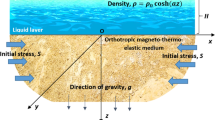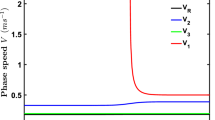Abstract
Analytic representations are obtained for the displacement and stress fields in the Rayleigh surface wave (R-wave) generated in an elastic half-space by an internal source that produces the same seismic P-wave as an underground explosion. Oscillograms, particle trajectories, and stresses in the half-space and on its surface are calculated. Relations for the energy flux in the R-wave are obtained. For rock salt, the fraction of the explosion energy transferred to the R-wave is estimated. It is established that this fraction can reach values of about 1% of the total explosion energy if the explosion is a contained one. As the charge depth is increased, the energy of the R-wave decreases in approximately inverse proportion to the depth.
Similar content being viewed by others
References
Lord Rayleigh (J. W. Strut), “On waves propagated along the plane surface of an elastic solid,” Proc. London Math. Soc., 17, 4–11 (1885).
K. Aki, M. Bouchon, and P. Reasenberg, “Seismic source function for an underground nuclear explosion,” Bull. Seismol. Soc. Amer., 64, No. 1, 131–148 (1974).
V. A. Simoneneko and N. I. Shishkin, “Cumulation of seismic waves during formation of kimberlite pipes,” J. Appl. Mech. Tech. Phys., 44, No. 6, 760–769 (2003).
H. Nakano, “On Rayleigh waves,” Jpn. J. Astron. Geophys., 2, 233 (1925).
E. R. Lapwood, “The disturbance due to a line source in a semi-infinite elastic medium,” Philos. Trans. Roy. Soc. London, A242, 63 (1949).
K. I. Ogurtsov and G. I. Petrashen’, “Dynamic problems for an elastic half-space in the case of axial symmetry,” Uch. Zap. Leningrad. Univ., Ser. Mat., 149, No. 24, 3–117 (1951).
G. I. Petrashen’, “Methods for studying wave processes in media containing spherical or cylindrical interfaces,” Uch. Zap. Leningrad. Univ., 170, No. 3, 96–220, (1953).
N. I. Onis’ko and E. I. Shemyakin, “Motion of the free surface of a homogeneous ground in an underground explosion,” Prikl. Mekh. Tekh. Fiz., No. 4, 82–93 (1961).
Z. Alterman and F. Abramovici, “Effect of the depth of a point source on the motion of the surface of an elastic solid sphere,” Geophys. J. Roy. Astron. Soc., 11, 189–224 (1966).
L. M. Brekhovskikh, “On the surface waves in solids confined by the curvature of the boundary,” Akust. Zh., 13, No. 4, 541 (1967).
N. A. Haskell, “Analytic approximation for the elastic radiation from a contained underground explosion,” J. Geophys. Res., 76, No. 10, 2583–2587 (1967).
D. Von Seggern and R. Blandford, “Source time functions and spectra for underground nuclear explosions,” Geophys. J. Roy. Astron. Soc., 31, Nos. 1/3, 83–98 (1972).
N. I. Shishkin, “On the problem of disintegration of rock by an explosion under the influence of a free surface,” J. Appl. Mech. Tech., 3, 401–408 (1981).
A. I. Shakhov and N. I. Shishkin, “On the problem of a confined explosion in an elastic half-space,” J. Appl. Mech. Tech., 38, No. 5, 655–665 (1997).
D. W. Patterson, “Nuclear decoupling, full and partial,” J. Geophys. Res., 71, No. 14, 3427–3436 (1966).
W. D. Werth, “Particle motion near a nuclear detonation in halite,” Bull. Seismol. Soc. Amer., 52, No. 5, 981–1005 (1962).
G. C. Werth and R. F. Werth, “Comparison of amplitudes of seismic waves from nuclear explosions in four mediums,” J. Geophys. Res., 68, 1463 (1963).
G. Werth and P. Randolph, “The Salmon seismic experiment,” J. Geophys. Res., 71, No. 14, 3405–3413 (1966).
H. Healy, Chi-Yu King, O’Neill, “Source parameters of the Salmon and Sterling nuclear explosions from seismic measurements,” J. Geophys. Res., 76, No. 14, 3335–3344 (1971).
H. Rodean, Nuclear Explosion Seismology, Atomic Energy Commission, Washington (1971).
Author information
Authors and Affiliations
Additional information
__________
Translated from Prikladnaya Mekhanika i Tekhnicheskaya Fizika, Vol. 47, No. 4, pp. 3–14, July–August, 2006.
Rights and permissions
About this article
Cite this article
Simonenko, V.A., Shishkin, N.I. & Shishkina, G.A. Movement of the ground in Rayleigh waves produced by underground explosions. J Appl Mech Tech Phys 47, 461–471 (2006). https://doi.org/10.1007/s10808-006-0078-0
Received:
Issue Date:
DOI: https://doi.org/10.1007/s10808-006-0078-0




